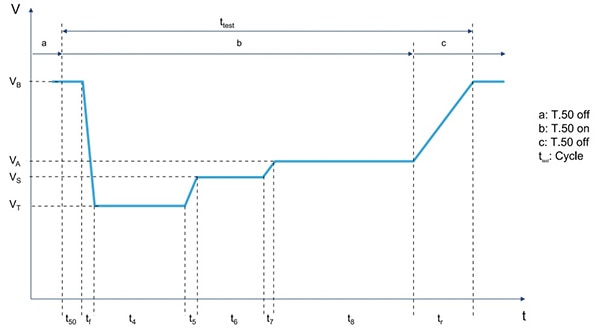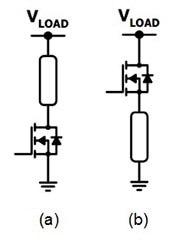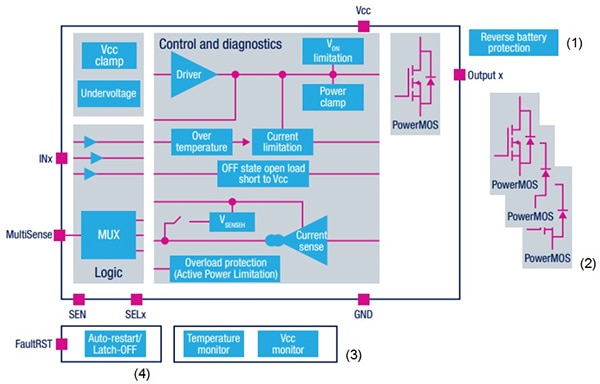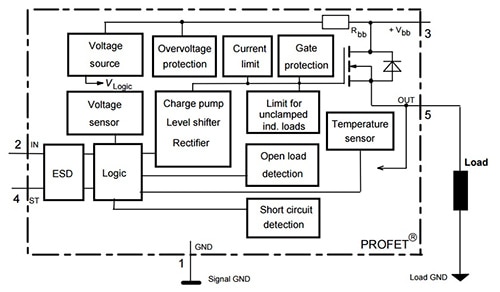Smart High-Side Drivers Help Meet Tough New Automotive Standards
投稿人:DigiKey 北美编辑
2016-05-19
To help meet tough emissions and fuel economy standards, automakers are increasingly turning to electronic components for assistance. Many formerly mechanical operations such as hydraulic-assist power steering are being replaced by electric motors; other functions are being combined, resulting in components such as the integrated starter/alternator (ISA).
The new electronic modules come at a price: they impose additional demands on the traditional 12 V power system, particularly during the cranking operation, when the battery-driven starter motor must rotate the engine until combustion begins. The heavy current draw during this time reduces the battery voltage to a fraction of its normal level. Cold temperature makes the problem worse, as it increases oil viscosity and therefore the load on the battery, reducing the voltage even further.
The recent introduction of stop/start technology, which automatically turns off the engine to reduce emissions and save gas when the vehicle is idling at a red light or stuck in traffic, makes the task of controlling the battery voltage even more difficult due to the large number of crank events.
The design complexity is compounded by strict automotive module operational and functional standards that must be met during crank to ensure safety, a better driver experience, or both.
Tougher Tests Reflect New Requirements
As the automotive electronic component count increases, standards agencies such as the International Standards Organization (ISO) and the Society of Automotive Engineers (SAE) are toughening the qualification tests that pertain to the cranking event. Figure 1 shows a typical test profile of voltage over time that simulates an engine crank. Initially the voltage is at VB, indicating the battery voltage under quiescent conditions. As the simulated engine starts to turn over, the load on the simulated battery increases causing the test voltage to drop to a low of VT, where it remains for time t4 until slowly recovering.

Figure 1: A typical cold-crank test profile has several sections that correspond to the different crank stages, from initial key-on to engine start. (Image courtesy of STMicroelectronics)
The ISO has issued a widely adopted set of standards covering the automotive electrical environment. Their ISO 7637-2 (test pulse 4) simulates the cranking event.
In Europe, a consortium of German manufacturers including Porsche, Volkswagen, BMW, and Audi have developed the LV 124 set of testing standards. The LV124 E-11 Start Pulse Test has two levels, "Normal" and "Severe"; each one defines a particular set of voltage levels and times according to the cranking profile shown in Figure 1. In the "Severe" test, the device must operate when VT is as low as 3 V.
Semiconductors as Relay Replacements
Even before the move towards increased electronic content, semiconductor drivers had been slowly replacing electro-mechanical relays in automobiles. Although relays are still popular for loads above 20 A, they are bulky, consume significant power during operation, are on/off devices, and cannot accommodate sophisticated diagnostic and protection strategies.
As relay replacements, semiconductor drivers have been particularly attractive in the following situations:
- Light loads less than 1 A
- Loads that require PWM control such as dimmable lamps, variable speed motors, loads that require soft-start operation
- Loads that have complex diagnostic or monitoring requirements
- High-side switched loads less than 20 A
High-Side vs. Low-Side Drivers

Figure 2: A low-side driver configuration (a) is best suited to powertrain loads such as motors and heaters, while a high-side driver configuration (b) is better suited to fuel pumps and body-related functions such as seats, lighting, wipers and fans. (Image courtesy of ON Semiconductor)
There are two basic ways of driving a load (Figure 2). A low-side driver is placed between the load and ground, whereas a high-side driver, shown in 2(b), is placed between the load and the supply voltage. The low-side driver is often used for powertrain-related loads such as motors, solenoids, and heaters. The high-side driver is used for fuel pumps, and body-related functions such as seats, lighting, wipers, and fans.
The two drivers differ primarily with respect to their response to fault conditions. In an automobile, a short-to-ground fault is more likely to occur than a short-to-supply fault, given that grounded sheet metal is everywhere to be found. For a low-side driver, a short-to-ground condition will turn the load permanently on. With a high-side driver, it will short the driver output to ground, so the driver will need protection circuitry.
The opposite condition will apply for a short-to-supply fault: the low-side driver will be shorted to the supply and need protection, while the high-side load will be permanently on.
This differing response is what determines the use of one driver over the other; in a fuel pump with a low-side driver, for example, a short-to-ground as a result of a crash may turn on the fuel pump with potentially catastrophic consequences.
Low-side drivers have been widely used in engine and transmission control since the 1980s, but the widespread adoption of high-side drivers is fairly new. Initial use was in body functions such as electric set motors or mirrors, but more recently the main factor has been the expansion of LED lighting. From its initial use in interiors, LED lighting has spread to turn signals and brake lights, and now is making its appearance in headlights. An automotive LED headlight system typically consists of a high-side smart LED driver controlling several LEDs in a series string.
Smart High-Side Driver Design
The design of a high-side driver is somewhat more complex than an equivalent low-side device; one reason is that it typically uses an n-channel MOSFET (NMOSFET) as the power element. NMOSFETs are preferred because they can be made smaller and more cheaply than p-channel devices for the same performance. An NMOSFET, though, turns on by raising the gate voltage above the drain voltage; in an automotive application, the drain voltage is usually the highest voltage in the system (i.e. the battery voltage), so a charge pump is needed to boost the gate voltage to a sufficient level.
To combine the control and power elements, a driver IC paired with a low on-resistance discrete MOSFET was the first approach due to packaging or process limitations, but newer devices have integrated both devices into a single package.
STMicroelectronics, for example, uses a fabrication process that allows the integration of a digital or analog control circuit with a vertical power transistor on the same chip (Figure 3). Under the VIPower moniker, the technology produces a monolithic silicon chip that combines both control and protection circuitry with a standard power MOSFET structure in which the power-stage current flows vertically through the silicon.

Figure 3: STMicroelectronics VIPower high-side power driver IC combines NMOS control circuitry with a vertical DMOS power transistor. Shown is the structure for first-generation (M0) devices; the VIPower family is now up to M7 level. (Image courtesy of STMicroelectronics)
The complete VIPower family now includes over 600 devices with a wide range of optional features. Figure 4 shows the block diagram of a VIPower device, plus four of the possible options:
- Reverse battery protection allowing self turn-on of power MOSFET
- Up to four channels with integrated power MOSFETs
- Expanded monitoring options
- Configurable auto-restart or latch-off
An example device, the VND7140AJ12, is a double channel high-side driver housed in a power SSO-12 package. The device drives 12 V automotive grounded loads through a 3 V and 5 V CMOS-compatible interface. It provides protection and diagnostics functions such as load current limitation, active management of power overloads, and over-temperature shutdown.
A current sense pin outputs a high-precision current that is proportional to the load current. It also indicates the detection of fault conditions such as overloads, shorts to ground or supply voltage, or open loads. A sense-enable pin allows off-state diagnosis functions to be disabled during low-power mode.

Figure 4: The VIPower HSD architecture includes a broad range of diagnostic and protection features. (Image courtesy of STMicroelectronics)
The VND7140AJ12 is designed to function during engine start pulses without external components. In particular, the part fulfills all functions during and after the LV 124 E-11 test for both "Normal" and "Severe" start pulses. This performance is classified as "Functional Status A", the highest level.
Other manufacturers take a different approach to smart driver integration. Infineon Technologies' PROFET family of smart high-side switches combines a DMOS power transistor with CMOS logic circuitry using a "chip-on-chip" technology with the logic IC mounted on top of the power transistor.
PROFET devices incorporate a broad range of features for fault diagnosis and offer protection against overloads, shorts, overtemperature, ground loss, power supply loss, and electrostatic discharge (ESD). They are also capable of protecting against dynamic overvoltage events such as load dump and inductive load turn-off. The BTS442E2, for example, features a maximum on-state resistance of 18 mΩ, a maximum operating voltage of 42 V, and a typical load current of 21 A.

Figure 5: The BTS442E2 PROFET smart high-side driver uses a "chip-on-chip" packaging technique with two separate die in a single package. (Image courtesy of Infineon Technologies)
The PROFET family has a wide variety of different ordering choices and includes the miniPROFET line in miniature power packages. The BSP452CT-ND, for example, is a single-channel device with a 160 mΩ power switch that can output up to 700 mA; it is packaged in a SOT223-4.
Other High-Side Partitioning Options
There are other options to meet the LV 124 and ISO7637-2 cold-crank requirements. Since it is not always possible to find high-side drivers that will function at the lowest test voltages as well as meet all the other application requirements, one option is to use a buck-boost DC-DC converter to maintain the supply voltage at an acceptable level. The LM5118 from Texas Instruments, for example, can maintain output regulation during a cold-crank event with input voltages as low as 2.5 V.
One solution using this approach could pair an LM8115 with a high-side driver such as TI's TPS2022DRG4Q1. This high-side device features a 33 mΩ MOSFET switch and includes short-circuit protection, thermal protection, and undervoltage lockout. Fortunately, there's options available in the TPS202x family.
Conclusion
Although low-side drivers have been used for many years, smart power drivers offering high-side outputs are finding increasing use in automotive applications, especially in body functions such as seats, mirrors, and LED lighting.
In addition, and working in parallel to push design requirements, the need to maintain operation under cold-crank conditions is giving rise to new, more rigorous standards such as the latest ISO7637-2 and LV 124 tests. Thankfully, manufacturers have stepped up with a new generation of drivers and design options to help designers meet these new challenges.

免责声明:各个作者和/或论坛参与者在本网站发表的观点、看法和意见不代表 DigiKey 的观点、看法和意见,也不代表 DigiKey 官方政策。








 中国
中国